Blagg's Blog
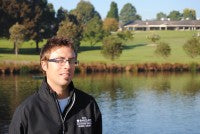 "I was left with a tough decision - to continue as a greenkeeper at Leek, find a way of pursuing my cricket groundsman career or apply for the Ohio State University Turf Grass Programme"
"I was left with a tough decision - to continue as a greenkeeper at Leek, find a way of pursuing my cricket groundsman career or apply for the Ohio State University Turf Grass Programme"
I am Simon Blagg, a twenty-three year old qualified greenkeeper. From a young age I have always loved being outside amongst nature and, consequently, became a keen gardener. My specific interest in turf started when I was around ten years old, after my older brother handed down one of his unwanted weekly chores and gave me permission to use the lawn mower. From that moment on I haven't really looked back!
After leaving High School aged sixteen, I was inspired to go on and study at Reaseheath College in Cheshire and gain a Horticulture Qualification. I started on the foundation course and worked my way, over four years, to a National Diploma in Horticulture and Sports Turf Maintenance. I graduated from Reaseheath with a number of 'Best Student' awards and a Triple Distinction in my final exams.
During my time at college, I was also able to secure a couple of really beneficial "eye opening" work experience placements. The initial placement was at Jack Barkers' Keele Golf Course; a municipal course on the border of Stoke on Trent. It was here that I really learned my basic golf course maintenance skills; bunker raking, hole changing, greens mowing and general golf course setup.
My second placement was at the Oval Cricket ground in London, home of Surrey County Cricket Club. This placement was perfect, as one of my main sporting passions is cricket and, at the time, I was playing for my local team. I spent five weeks working at the Oval and learning from, in my opinion, one of the best cricket groundsman in the country - Bill Gordon. The Year was 2005; a massive season of cricket in England, as it was the Ashes winning summer when England secured the series at the Oval, which always hosts the final Test.
In the spring of 2006, with one more year left at college, I set myself a new goal; to try and become the youngest cricket groundsman in my local Stone and District
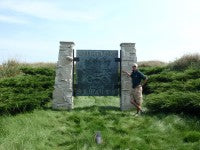 Cricket league. Fortunately (aged 19), I was offered a position as groundsman at my local club - Maer and Onneley CC.
Cricket league. Fortunately (aged 19), I was offered a position as groundsman at my local club - Maer and Onneley CC.
Although I was still at college completing my studies, I was then offered a further employment opportunity at Leek Golf Club, working under a fantastic Head Greenkeeper, John Turner, and his assistant, Steven Parr. Steven has since, sadly, passed away. He was a true inspiration for me, and is greatly missed. Leek Golf Club is a private club in Staffordshire, and highly regarded as one of the best clubs in the county.
John had grown up working on Links courses and was heavily into sustainable greenkeeping. He worked tirelessly and managed to get Leek accredited to the magnificent 'Royal and Ancient' programme.
He taught me a significant amount about sustainability, including the effects it can have on your budget and the overall quality of the playing surfaces.
During this time, I was still maintaining the Maer cricket square and, by the end of the summer of 2007, had achieved best cricket square in the league two years running.
In the winter of 2007, at the age of twenty, I was left with a tough decision - to continue as a greenkeeper at Leek, find a way of pursuing my cricket groundsman career or, alternatively, apply for the Ohio State University Turf Grass Programme in the USA.
Looking back now, I'm really thankful I chose the Ohio option. It was a perfect opportunity to explore a new country, whilst still pursuing my career. This, however, was a huge step for me - new people, new environment and a new culture.
I sent my CV and application through to Mike O'Keeffe and was subsequently offered a "twin location" internship on the programme.
 The OSU Programme is of 12-18 months' duration. I started off at Whistling Straits in Wisconsin - from March through to October - and then moved down south to the Doral Golf Resort in Florida.
The OSU Programme is of 12-18 months' duration. I started off at Whistling Straits in Wisconsin - from March through to October - and then moved down south to the Doral Golf Resort in Florida.
This all began in March 2008. After a few days initial orientation in Ohio, I flew into Milwaukee airport and was taken to my first base at Whistling Straits, around sixty miles north of Milwaukee on the waterfront of Lake Michigan.
Whistling Straits is a Kohler Resort course, and a championship course that has already hosted the 2004 PGA, the 2007 Senior Open Championship and, last year, the 2010 PGA championship - which I was lucky enough to return to as a volunteer for the tournament. In the future, this venue will host the 2015 PGA Championship and the Ryder Cup in 2020.
There are two courses on the site; the Straits course (Tournament course), that runs along the waterfront of Lake Michigan, and the Irish course that runs immediately behind the Straits course. Both courses are designed by the legendary Pete Dye, who created Sawgrass, Harbour Town Links and many more. Both the Straits and the Irish courses are US design examples of Scottish and Irish Links courses.
During my internship, I worked on the Irish course with Superintendent at the time, Grant Davey, and Assistant Superintendents, Travis Schnelle and Emily Shircel. I was also joined and worked alongside Scott MacNicol, a Scottish Ohio intern from Glasgow.
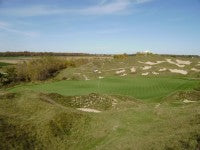
Whistling Straits was both an interesting and challenging course to work at, mainly due to its multiple bunkers (roughly 1000). Some range from huge sand pro bunkers to tiny little pot bunkers. They provide a monumental maintenance task during the summer. Turf cultivars on the Irish course at Whistling consist of Providence bentgrass greens, Penncross bentgrass tees and Penn-trio fairways. Penn-trio is a blend of penn links, penn eagle and penncross.
My internship at Whistling straits was truly outstanding. From the moment I arrived, I was heavily involved with the spring greens renovation. This was the first time I had ever seen extensive damage from ice. The winter period, from 2007 to early 2008, was particularly bad due to the persistent snow and ice coverage, creating several issues.
The fairways on the Straits course are fescue, with a percentage of Poa annua. Depending on conditions, Poa will survive around thirty days under ice coverage before the plant is killed, whilst fescue will survive around twenty days under ice coverage before it is killed. Due to the extreme weather, some of the low lying areas on the fairways of the Straits course were totally wiped out.
In addition to greenkeeping, I was also trained as an Irrigation Technician throughout the internship. At Whistling Straits, the irrigation setup is a 'Rain Bird' system,
 which is operated through Cirrus Software. Once again, due to the cold weather, the irrigation pipes would become brittle and, when pressure was pumped back into the lines, often a lot of swing joints would blow out.
which is operated through Cirrus Software. Once again, due to the cold weather, the irrigation pipes would become brittle and, when pressure was pumped back into the lines, often a lot of swing joints would blow out.
As well as repairing swing joints, I was also in charge of ensuring that the playing surfaces had sufficient water, conducted sprinkler repairs, irrigation clock maintenance and the adjustment of arcs.
Another task I performed was several chemical applications to the fairways. Fortnightly, they were sprayed with 'Daconil - all weather stick', Banner Max and Trimmit. Trimmit acted as a growth regulator - specifically for the suppression of Poa annua.
Towards the end of my internship in September, the long fescue rough had to be cut down. Fifty-two acres (twenty-one hectares) was cut short to enable a good seed production for the following season. This mammoth task was completed by large strimmer crews of ten or more, and two Steiner rough mowers and, hole by hole, the course was cut and collected.
My internship was completed at Whistling by the end of October 2008. I then headed to the OSU Turf Grass Short Course Seminar, held in South Carolina. It was a two day event where turf grass classes were held by OSU lecturers and guest speakers. It was a great chance to meet other interns who were also on the programme. The two day workshop included a tour of the famous Harbour Town Links golf course.
Scott and I then both headed further south to winter in Florida, where we completed the second part of the internship at the famous Blue Monster Course at Doral (owned by the Marriot Hotel Group). At Doral we were joined by two other British interns - Ian Lloyd and Paul McCormack.

The resort consists of five golf courses; the famous Blue Monster (Tournament course), the Great White course (a Greg Norman design and the only course of its kind in southeastern USA that uses a product called Coquina - crushed shells). The course has no rough, and this is replaced with the crushed shells; giving the course a totally different appearance. The Red, Gold and Silver courses are all much smaller and slightly easier for the novice golfer.
At the time of my internship they were reconstructing the Silver course. Jim Mclean, the course architect, made some drastic changes to improve the quality of the course. In the southern USA, the turf cultivars are totally different to that of northern states, as the climate is completely different. Warm season grasses, such as Tiffeagle bermudagrass, are grown on the greens on the Blue Monster course as the climate is warm enough all year round.
Every March, Doral's Blue Monster course hosts the World Golf Championship. The top fifty ranked golfers in the world come and play the tournament and try to gain points for the Fedex cup. My internship was based at the Blue Monster course, working under the Course Superintendent, Ronnie Rooks, as his second assistant. As soon as I began work here, I was in charge of changing the holes for the tournament, as well as helping with the extensive preparation that occurred. Other tasks involved irrigation responsibilities, fertility and plug relocations and running the crew during the preparation of the bunkers.
It is imperative to place great importance on the plug relocation on Tiffeagle greens, due to the heavy grain, as the turf spreads through stolons and rhizomes. If a plug is placed in the wrong direction it will become visible.
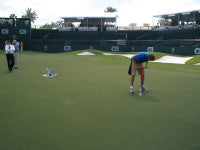
The grain on the plug has to match up with the surrounding grain. One of my earliest career highlights was changing the finishing holes on the back nine during the tournament. This particular tournament was when Tiger Woods was making his return to golf following knee surgery. Thankfully, I had months of preparation to ensure that my hole changing was nothing less than 100%.
It had to be so perfect that the PGA insisted I lay all of my hole changing tools out on a towel first, just in case I appeared on television! Despite the golf course being rather dry, due to a lack of seasonal spring showers, all the professionals were very happy with the way the course played.
In the spring of 2009, following completion of my OSU programme, I headed back to England to take up a new position, as a seasonal greenkeeper at Loch Lomond Golf Club in Scotland. This had been researched and arranged earlier, whilst still living and working in Florida and included a very interesting and sleepy 5.00am phone interview with Superintendent, David Cole!
This was, yet again, another spectacular summer for me, as Loch Lomond hosted the Barclays Scottish Open in July, the week before the British Open.
 Loch Lomond Golf Club is in a truly spectacular location, with views of Ben Lomond from the loch shore. The climate in the west of Scotland is totally opposite to Florida, significantly cool, moist and very inconsistent. The average rainfall is approx 2000mm per year. This means that the drainage system has to be very advanced in order to cope.
Loch Lomond Golf Club is in a truly spectacular location, with views of Ben Lomond from the loch shore. The climate in the west of Scotland is totally opposite to Florida, significantly cool, moist and very inconsistent. The average rainfall is approx 2000mm per year. This means that the drainage system has to be very advanced in order to cope.
Originally, when the course was built, a lot of road spoil was used to construct the fairways and surrounds. A small amount of drainage was installed, but not enough to deal with heavy rainfall - especially when the course was hosting a tournament.
In order to improve the course's condition, the club purchased drainage equipment including a Fendt Tractor, Shelton Wizzwheel, a sand hopper and, most importantly, pipe, sand and gravel. Project work included sand scraping the worst areas (hard rock). One of the biggest areas was the second leg of the tenth fairway.
The turf cultivars at Loch Lomond consist of brown top bent and Poa annua blend greens, bentgrass tees and fairways and perennial ryegrass rough.
 May, June and July were the busiest months on the golf course - preparing for the Barclays Scottish Open. My main responsibility for the tournament was mowing the greens (using a John Deere 180C greensmower). This was my first experience of greens mowing in a professional tournament, so preparation was essential. The week before the tournament was really full on - getting the greens up to speed with double cutting and rolling. We recorded our clipping yield, which gave us a great idea of growth rate, and predicted whether we needed to perform another cut or roll.
May, June and July were the busiest months on the golf course - preparing for the Barclays Scottish Open. My main responsibility for the tournament was mowing the greens (using a John Deere 180C greensmower). This was my first experience of greens mowing in a professional tournament, so preparation was essential. The week before the tournament was really full on - getting the greens up to speed with double cutting and rolling. We recorded our clipping yield, which gave us a great idea of growth rate, and predicted whether we needed to perform another cut or roll.
As requested by the European Tour management, the greens had be running around 10 to 10.5 on the stimp. Thankfully, the weather, during the 2009 Open week was, to say the least, perfect. A moment I will never forget was when the crew headed over to the back of the 18th on Sunday evening to watch the final groups come through. We then, following tradition, had a photo with the winner.
The next step for me - Australia! I had been planning this throughout the summer in Scotland, hoping, one day, to work at the Australian Open.
Once again, I was lucky enough to gain a working holiday visa, and was offered a position by the New South Wales Golf Club. This is a links style golf course in La Perouse, south Sydney, dating back to the early 1920s and designed by Alistair McKenzie. I worked under the Course Superintendent, Gary Dempsey.
This was the first time the course had hosted the Australian Open and, so, was a new experience for everyone. The course had gone through some serious renovation programmes over the previous years, redeveloping the bunkers to a revetted style and changing the layout of the 18th fairway and green.
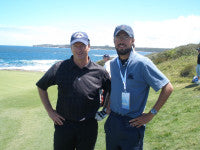 The greens at New South are a creeping bent and poa annua blend. Tees, fairways and rough are largely couch grass (Bermuda) with a percentage of Kikuyu in the rough. The particularly cool spring in Sydney resulted in the couch grass fairways taking longer than expected to come out of winter dormancy. Fertiliser rates were increased on all playing surfaces to tighten up areas.
The greens at New South are a creeping bent and poa annua blend. Tees, fairways and rough are largely couch grass (Bermuda) with a percentage of Kikuyu in the rough. The particularly cool spring in Sydney resulted in the couch grass fairways taking longer than expected to come out of winter dormancy. Fertiliser rates were increased on all playing surfaces to tighten up areas.
Again, as at the Scottish Open, I cut the greens for the tournament (using Toro Flex 18'' greensmower).
All was going well, until a 75km south easterly wind blew up on the Friday morning. This caused havoc on the coastal 6th and 13th greens. The pros couldn't hold their putts, as the balls were blowing off the greens! Although the greens preparation had been authorised by Golf Australia, Stuart Appleby certainly didn't approve - blaming the greens staff for the uncontrollable mess, despite being six under and leading the tournament at the time. Adam Scott eventually won the tournament at 15 under par.
Steve Mallyon (Assistant at Roseville Golf Club, Sydney) was one of the volunteers I met during the Aussie Open. He and I worked closely alongside each other, and are now good friends. After my six months at NSW Golf Club, I once again headed back to Scotland and Loch Lomond for another season. Steve came over and volunteered for two weeks at the Barclays Scottish Open, and then moved to St Andrews to experience the British Open.
Thanks to Steve, I secured a full-time position at Roseville Golf Club in North Sydney. The superintendent, Mark O'Sullivan, arranged a sponsorship visa through the club. Roseville dates back to 1923, and is a Par 66 course with tight tree lined fairways and tricky par threes - making the course very challenging.
I have now settled at Roseville and am thoroughly enjoying living in Sydney. I am hoping to be here for a few seasons, and look forward to watching Roseville develop through its current projects.
My story proves how important networking is - it certainly gets you places! I wouldn't be here today if it weren't for a group of people who have taught me some outstanding skills, and encouraged me to continue with my hard work.
Firstly, my family. Although I have barely seen them for the past few years, the encouragement has not stopped. A Christmas with them this year is certainly on the books!
Secondly, Mike O'Keeffe from Ohio State University. He has been a tremendous mentor and I can't thank him enough for the help and advice he has given me.
Thirdly, to all of the superintendents and assistants I have been lucky enough to work under and learn so much from; John Turner at Leek Golf Club, Grant Davey, Matt Zhemes, Emily Shircel and Travis Schnelle at Whistling Straits, Ronnie Rooks at Blue Monster, David Cole, Peter Hagerty and Sue Rothwell at Loch Lomond, Gary Dempsey at New South Wales Golf Club, and Mark O'Sullivan from Roseville Golf Club.
If anyone is interested in looking to progress in the turf industry - go for it. The benefits more than outweigh the hard work, and it truly has been life changing.
Please don't hesitate to contact me at Simon.blagg@googlemail.com. I am more than happy to further discuss my experiences and offer any advice.
Mike O'Keeffe can be contacted at okeeffe.1@osu.edu. It could be the best thing you ever do!
Article Tags:
Golf